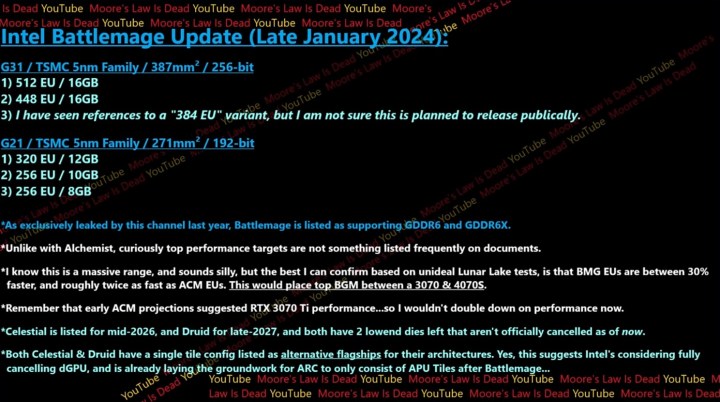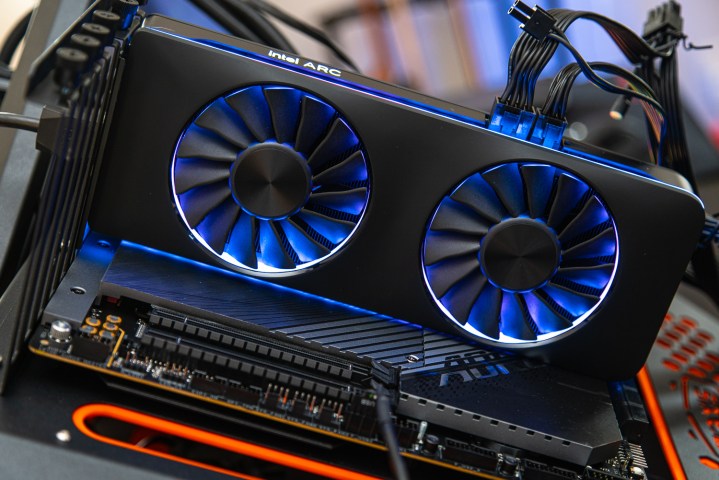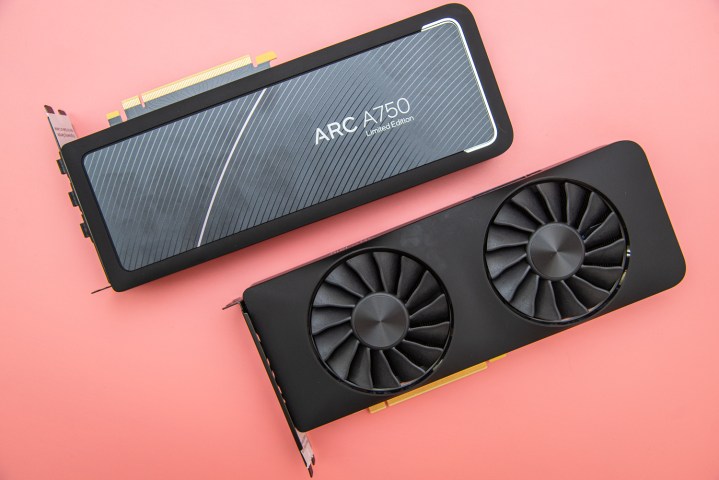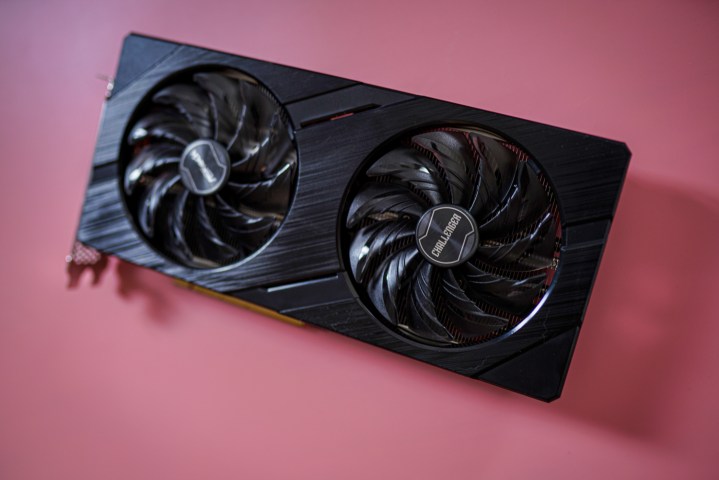Intel faced an uphill climb with Arc Alchemist, and it looks like it might have another fight ahead with its next-gen Battlemage GPUs. The competition is always fierce, and AMD and Nvidia have big plans for the year ahead.
Despite the clouds that loom on the horizon, Intel might still surprise us with Battlemage — in a good way. Here’s where Intel Arc Battlemage is currently at, and why it might have a shot at being one of the best GPUs of the year.
Déjà vu
Prior to the release of Intel Arc Alchemist, one of the main complaints was that the general public was kept in the dark a lot of the time. The release date was pushed back more than once, and the information about the GPUs was fairly scarce compared to the constant hype we’ve all grown used to with Nvidia and AMD leaks.
This is kind of where we’re at with Battlemage right now, too, and that’s a shame. The little we do know mostly comes from rumors.
For instance, what kind of performance can we expect from Arc Battlemage? It’s safe to say that Nvidia’s RTX 50-series or AMD’s RDNA 4 won’t have to worry about it, but current-gen cards may feel the heat. The exact specs are unknown, and no wonder — we’re still in the early days. The rumors have been growing less and less optimistic, though.

Early leaks speculated that the flagship Arc Battlemage might compete against Nvidia’s RTX 4070 Ti in gaming. Since then, YouTuber RedGamingTech reported that the specs have been cut down significantly.
The flagship is now said to come with 40 Xe cores, a maximum clock of 3GHz, GDDR6 or GDDR6X VRAM with a 192-bit bus, and 18MB of L2 cache. For comparison, the Arc A770 has 32 Xe cores. It’s hard to imagine this GPU beating the RTX 4070 Ti.
YouTuber Moore’s Law Is Dead also released an update of the specs, showing models ranging from 512 execution units (EUs) to 256 EUs. That’s the same maximum number of EUs as the Arc A770. Other rumors are quite contradictory, though, with PCGamer claiming that Battlemage will double the number of shaders and increase efficiency, and that the Xe core count should be “a lot higher.”
Intel, obviously, shares that optimistic outlook. Tom Petersen, an Intel fellow, recently spoke about the development of Battlemage, and things appear to be on the right track. A lot of Intel engineers are said to have moved on to developing the next generation of GPUs, meaning Arc Celestial, while the software team is tweaking Battlemage to prepare for its release — which could be in 2024, but early 2025 might be a safer estimate.
The uncertainty stretches to more than just when Battlemage will come out. It’s easy to imagine that Intel’s entire graphics division may have gone through some shifts when its chief, Raja Koduri, departed last year to lead a startup centered around generative AI.
Thank you Pat and @intel for many cherished memories and incredible learning over the past 5 years. Will be embarking on a new chapter in my life, doing a software startup as noted below. Will have more to share in coming weeks. https://t.co/8DcnNdso3r
— Raja Koduri (@RajaXg) March 21, 2023
On the other hand, that change, while massive, shouldn’t affect the development of Battlemage too much. The generations that follow it, though, might feel the brunt of that impact, which is where that sense of uncertainty creeps back.
As things stand now, we don’t even know whether Intel will stick to mobile chips or also release desktop versions of Battlemage, much less what lies beyond that.
Laptops? Desktops? Who knows

Intel Arc Alchemist appeared both in desktop and laptop versions, but the same may not be true for Battlemage. According to Moore’s Law Is Dead, a reportedly leaked Intel document implies that there may be no dedicated Battlemage graphics in laptops.
This suggests that we might be dealing with a solely desktop chip, which would be a bit odd given that entry-level gaming laptops are a good place for a GPU like Battlemage to thrive. (Then again, there weren’t many Alchemist-based laptops, either.)
It’s too early to tell whether discrete Battlemage GPUs will appear in laptops.
A recent article from Wccftech reveals that Linux Kernel patches sent by Intel include support for Xe2 Battlemage iGPUs, and more specifically, for Adaptive Sharpening Filter technology. This is a filter that works through the display engine to apply sharpening, both in games and in videos, and its strength can be configured from 0 (disabled) to 255 (maximum).
These iGPUs are said to be included on next-gen Lunar Lake CPUs, which is Intel’s next-gen laptop range. Desktop chips are called Arrow Lake this time around.
It’s too early to tell whether Battlemage will appear in laptops beyond integrated graphics solutions. Similarly, it’s hard to know what the future may bring when it comes to Intel Arc Celestial and Intel Arc Druid. However, there have been whispers about Intel possibly canceling its discrete graphics division at that point.
We’re again relying on Moore’s Law Is Dead for leaks here. The YouTuber said that internal Intel documents list both Celestial and Druid as a single-tile configuration. This was listed as “alternative flagships,” and there are reportedly still two low-end dies that haven’t been officially canceled. However, if this does come to pass, both Celestial and Druid may only exist as APU GPU tiles.
With anywhere between nine months and over a year left until the launch of Intel Arc Battlemage, we’re still dealing with less-than-reliable rumors instead of official information.
However, the things we do know for a fact indicate that Intel might be more successful with Battlemage than it might seem at first glance.
Intel’s biggest obstacle doesn’t exist anymore

I’ve said it above and I’ll say it again — Arc Alchemist has had a rocky start.
It’s hard enough to break into a market that’s so thoroughly dominated by just two tech giants. Intel has the advantage of being a well-known global brand due to the fact that it makes some of the best processors, but just as it benefits from brand recognition in the CPU market, so does Nvidia in the graphics segment. It’s a difficult obstacle to overcome.
Arc Alchemist also faced a lot of issues following its launch. Not only was it delayed and less impressive than some might have expected, but it also suffered from various driver issues. It was fine enough if you were playing newer games, but older, DirectX 9-based titles were almost unplayable, and even DX11 and DX12 titles required optimization. The issue with DX9 was rooted deep within the software. Alchemist used D3D9on12 for DirectX 9 titles, meaning that it relied on DX12 to “translate” DX9 instructions, wasting the hardware potential of these graphics cards.
The company never tried to sugarcoat the state of Alchemist before it hit the shelves. While those messages were carefully worded, Intel was upfront about it — there was still some work to be done. It highlighted the performance of Arc in DX12 titles and promised improvements in older games.
It didn’t happen all at once, but over time, those driver updates added up to a wholly redesigned GPU lineup.

Retesting the Arc A770 and the Arc A750 a few months later showed massive improvements. The A750 went from 56 frames per second (fps) in Cyberpunk 2077 at 1080p to 76 fps, outperforming Nvidia’s RTX 3060 Ti. It’s not just newer games that saw improvements. Intel started from scratch to implement native DX9 support. It also addressed driver bottlenecks caused by resource allocation issues in DX11.
Patch after patch, Arc Alchemist went from being a risky experiment to being a powerful alternative to AMD and Nvidia. This was a true testament to the power of software optimization.
Yes, Intel Arc was riddled with problems near its launch, but that doesn’t mean Battlemage will end up in that same position. These lessons have already been learned. Intel found the fixes and workarounds and stayed consistent with its driver updates, fixing what was broken until it finally worked. Now, Arc A770 and Arc A750 are viable GPUs in their price range.
This brings me to the second part of Intel’s strategy that worked great — the pricing.
The GPU that the market needs

Intel knew the kind of product it was bringing out when it launched Alchemist. Petersen and Ryan Shrout (who has since left Intel) both spoke candidly about the capabilities of Alchemist, but they were also clear about one thing — Intel had a plan, and it wasn’t to win in performance.
Instead of marketing Alchemist as the most powerful GPU on the market — which it was most certainly not — Intel targeted performance-per-dollar.
The Arc A770 launched at $350 for the 16GB version, while the Arc A750 had a list price (MSRP) of $290. That made these GPUs cheaper than their AMD and Nvidia counterparts. Initially, this strategy wasn’t as visible due to the aforementioned issues with Alchemist, but now, it’s a whole different story.
Intel’s Arc A770 can be found for sale for as little as
, and it can outperform similar GPUs both in rasterization and in ray tracing. AMD’s previous-gen cards are no fans of ray tracing workloads, but Intel tackles those with relative ease, competing against even Nvidia’s current-gen RTX 4060 Ti.

Intel didn’t manage to make a splash with Arc Alchemist. In fact, I don’t personally know anyone who owns these GPUs outside of the realm of testing purposes. In a way, that’s not surprising, considering they’re a first-gen product. Many view these kinds of purchases as a leap of faith.
But moving on to Battlemage, I believe that Intel is much better equipped to compete against Nvidia and AMD. It doesn’t even need to make any major changes. If it can repeat the strategy it stuck to with Arc Alchemist, it’ll already be off to a great start.
Without the issues that plagued the cards at launch, and with the same value-oriented mindset, Intel could target the most populated parts of the discrete GPU market — the entry-level and midrange segments. Most of us aren’t running rigs with RTX 4090s, and cards like the RTX 3060 or the GTX 1650 dominate Steam’s Hardware Surveys. These graphics cards, focused on value instead of pure performance, are what gamers need these days — and Intel can most likely deliver that.
Even if Intel does give up on making discrete GPUs with Arc Celestial and Druid, some gamers may still benefit. The gaming handheld market is growing rapidly, and for Intel to tap into that in a big way would be a great move, delivering solid graphics performance and directly rivaling AMD.
This is why I’m looking forward to Arc Battlemage. Just like Nvidia may have learned its lesson recently, Intel learned a lot through Arc Alchemist. If it applies those lessons to Battlemage, those GPUs might end up being the best value picks of the year.
Editors’ Recommendations







